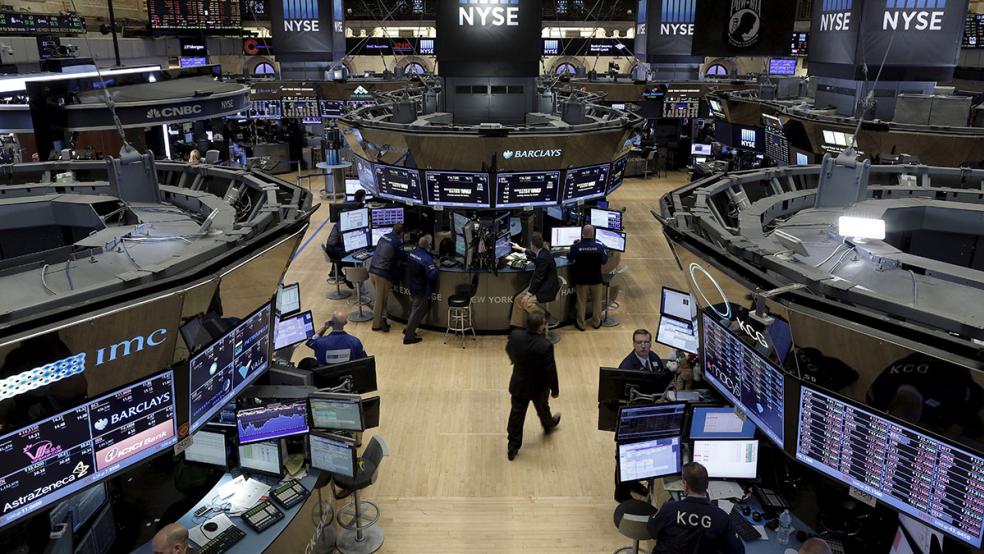On the surface, Wall Street is in the midst of an uneasy standoff. After a historic nine-week rebound rally, the Dow Jones Industrial Average now trades near levels first reached in late 2014, just below massive resistance around 18,000. The trading range between 17,800 and 17,500 has contained trading since the middle of March.
Yet a new long-term bear market seems to have started last May, based on the pattern of lower highs and lower lows on the NYSE Composite and the Russell 2000 Small-Cap Index, both of which are trading at levels first reached in late 2013. U.S. investors are holding a $1 trillion bet against stocks.
Are the bears right? Or are they about to get smashed, once again, as the seven-year Fed-fueled bull market rages on?
Related: Will a Profits Recession Lead to an Economic One?
To be sure, the fundamentals are challenging, with both earnings and U.S. GDP growth hurting as of late. The Atlanta Fed cut its GDPNow estimate of first-quarter growth to just 0.1 percent. First-quarter earnings for the S&P 500 are expected to decline about 10 percent from last year, the fourth consecutive quarter of falling profitability and the worst showing since 2009.
Reporting kicked off with a disappointment from aluminum maker Alcoa (AA) Monday evening: Sales of $4.95 billion missed the $5.27 billion analysts were expecting. On a GAAP basis, which removes much of the accounting shenanigans, earnings per share were just $16 million, or less than a penny per share.
The reporting season trudges on with a spate of big bank results later this week. JPMorgan (JPM) beat expectations before the bell Wednesday, though its profit dropped to $5.52 billion from $5.91 billion in the first quarter last year.
Bank of America (BAC) and Wells Fargo (WFC) will report Thursday morning, and Citigroup (C) will report on Friday. Results are likely to be pressured by a drop in long-term Treasury yields earlier this year (which pressures net interest margins) while a collapse in first-quarter mergers and acquisitions to levels not seen since the first three months of 2014 are going to weigh on investment bank revenues.
Related: What Donald Trump Gets Right About Stocks and the Economy
Stocks have been kept out of the abyss by the Federal Reserve’s modified rate hike plans for 2016 and by ongoing hopes of a persistent recovery in energy prices. The Energy Select SPDR (XLE) climbed above its 200-day moving average for the first time since September 2014 on Tuesday thanks to renewed chatter about a Saudi-Russia production freeze agreement. Tehran had been demanding that any production freeze be set at its pre-sanctions output level of around 4 million barrels per day vs. around 3.4 million now.
Yet these reports stand in contrast to recent comments by Saudi deputy crown prince Mohammed bin Salman, who suggested the kingdom would only participate in an agreement if Iran played ball. No less than Goldman Sachs warned clients that market expectations seem to be getting extended vis-à-vis the prospects and viability of any deal, adding that they see greater odds of a bearish dynamic following the meeting.
Related: Why Oil Prices Are Hitting 5-Month Highs
After all, Riyadh and Tehran are locked in a religion-based proxy war throughout the Middle East. Not exactly the type of good faith needed to lock down a deal. And with crude oil rallying 21 percent over the last six days, Russia and OPEC better deliver an agreement that goes against their individual self-interest — especially since it risks ceding market share to U.S. shale producers that have yet to suffer a round of widespread defaults and bankruptcies.
A pause on Fed rate hikes and a rebound in energy prices, on the surface, seem like positives. And over the near-term, they are. But both only sow the seeds of destruction — for a bull market dependent upon the flow of cheap credit to corporate balance sheets to fund share buybacks and dividends — by potentially pushing inflation rapidly higher.
Related: Why One Analyst Says Oil Could be at $85 by 2017
It's ironic that the catalyst for the epic market rip out of the Feb. 11 low will also, based on current trajectories, be responsible for its undoing.
A rate hike delay and higher energy prices will only encourage further acceleration in inflation pressure — which, by the Fed's preferred measure shown above, is rapidly bounding toward their 2 percent target. A tightening job market, higher shelter costs and higher medical costs are all contributing to the increase.
Should inflation start chugging toward 3 percent, the Fed won't be able to respond to every little market selloff as it has over the last few years: with the promise of a pause in policy tightening or well-placed hints of negative interest rates or more bond-buying. The resulting rise in long-term bond yields will pinch off the major source of new money into stocks. Without the buying demand, stocks will fall.
Last year, according to Yardeni Research, buybacks and dividends hit a record of $954 billion vs. a prior high of $835 billion in 2007. From 1Q09 to through 4Q15, buybacks and dividends totaled $4.8 trillion. In comparison, according to the Fed's flow of funds database, equity ETF inflows totaled $223 billion, foreign inflows totaled $111 billion, equity mutual fund inflows totaled $97 billion.
On balance over this period, institutional investors pulled around $211 billion out of the market while households pulled $169 billion.






